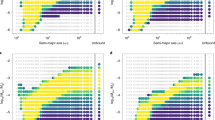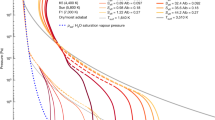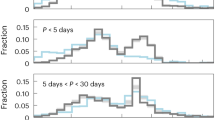Abstract
Ongoing and future space missions aim to identify potentially habitable planets in our Solar System and beyond. Planetary habitability is determined not only by a planet’s current stellar insolation and atmospheric properties, but also by the evolutionary history of its climate. It has been suggested that icy planets and moons become habitable after their initial ice shield melts as their host stars brighten. Here we show from global climate model simulations that a habitable state is not achieved in the climatic evolution of those icy planets and moons that possess an inactive carbonate–silicate cycle and low concentrations of greenhouse gases. Examples for such planetary bodies are the icy moons Europa and Enceladus, and certain icy exoplanets orbiting G and F stars. We find that the stellar fluxes that are required to overcome a planet’s initial snowball state are so large that they lead to significant water loss and preclude a habitable planet. Specifically, they exceed the moist greenhouse limit, at which water vapour accumulates at high altitudes where it can readily escape, or the runaway greenhouse limit, at which the strength of the greenhouse increases until the oceans boil away. We suggest that some icy planetary bodies may transition directly to a moist or runaway greenhouse without passing through a habitable Earth-like state.
This is a preview of subscription content, access via your institution
Access options
Access Nature and 54 other Nature Portfolio journals
Get Nature+, our best-value online-access subscription
$29.99 / 30 days
cancel any time
Subscribe to this journal
Receive 12 print issues and online access
$259.00 per year
only $21.58 per issue
Buy this article
- Purchase on Springer Link
- Instant access to full article PDF
Prices may be subject to local taxes which are calculated during checkout




Similar content being viewed by others
References
Buratti, B. & Veverka, J. Voyager photometry of Europa. Icarus 55, 93–110 (1983).
Howett, C. J. A., Spencer, J. R., Pearl, J. & Segura, M. Thermal inertia and bolometric bond albedo values for Mimas, Enceladus, Tethys, Dione, Rhea and Iapetus as derived from Cassini/CIRS measurements. Icarus 206, 573–593 (2010).
Showman, A. P. & Malhotra, R. The Galilean satellites. Science 286, 77–84 (1999).
Hoffman, P. F., Kaufman, A. J., Halverson, G. P. & Schrag, D. P. A Neoproterozoic snowball Earth. Science 281, 1342–1346 (1998).
Tajika, E. Snowball planets as a possible type of water-rich terrestrial planets in the extrasolar planetary system. Astrophys. J. Lett. 680, L53 (2008).
Walker, J. C. G., Hays, P. B. & Kasting, J. F. A negative feedback mechanism for the long-term stabilization of Earth’s surface temperature. J. Geophys. Res. 86, 9776–9782 (1981).
Menou, K. Climate stability of habitable Earth-like planets. Earth Planet Sci. Lett. 429, 20–24 (2015).
Kasting, J. F., Whitmire, D. P. & Reynolds, R. T. Habitable zones around main sequence stars. Icarus 101, 108–128 (1993).
Shields, A. L., Bitz, C. M., Meadows, V. S., Joshi, M. M. & Robinson, T. D. Spectrum-driven planetary deglaciation due to increases in stellar luminosity. Astrophys. J. Lett. 785, L9 (2014).
Ramirez, R. M. & Kaltenegger, L. Habitable zones of post-main sequence stars. Astrophys. J. 823, 1–16 (2016).
Wolf, E. T., Shields, A. L., Kopparapu, R. K., Haqq-Misra, J. & Toon, O. B. Constraints on climate and habitability for earth-like exoplanets determined from a general circulation model. Astrophys. J. 837, 1–11 (2017).
Pierrehumbert, R. T. Principles of Planetary Climate (Cambridge Univ. Press, 2010).
North, G. R. Analytical solution to a simple climate model with diffusive heat transport. J. Atmos. Sci. 32, 1301–1307 (1975).
Ishiwatari, M., Nakajima, K., Takehiro, S. & Hayashi, Y.-Y. Dependence of climate states of gray atmosphere on solar constant: from the runaway greenhouse to the snowball states. J. Geophys. Res. 112, D13120 (2007).
Pierrehumbert, R. T. High levels of atmospheric carbon dioxide necessary for the termination of global glaciation. Nature 429, 646–649 (2004).
Pierrehumbert, R. T., Abbot, D. S., Voigt, A. & Koll, D. D. B. Climate of the Neoproterozoic. Annu. Rev. Earth Planet. Sci. 39, 417–460 (2011).
Hu, Y., Yang, J., Ding, F. & Peltier, W. R. Model dependence of the CO2 threshold for melting the hard snowball Earth. Clim. Past 7, 17–25 (2011).
Abbot, D. S. et al. Clouds and snowball Earth deglaciation. Geophys. Res. Lett. 39, L20711 (2012).
Abbot, D. S. Resolved snowball Earth clouds. J. Clim. 27, 4391–4402 (2014).
Kasting, J. F., Chen, H. & Kopparapu, R. K. Stratospheric temperatures and water loss from moist greenhouse atmospheres of Earth-like planets. Astrophys. J. Lett. 813, L3 (2015).
Ingersoll, A. P. The runaway greenhouse: a history of water on Venus. J. Atmos. Sci. 26, 1191–1198 (1969).
Brandt, R. E., Warren, S. G., Worby, A. P. & Grenfell, T. C. Surface albedo of the Antarctic sea ice zone. J. Clim. 18, 3606–3622 (2005).
Meinshausen, M. et al. Greenhouse-gas emission targets for limiting global warming to 2 °C. Nature 458, 1158–1162 (2009).
Warren, S. G., Brandt, R. E., Grenfell, T. C. & Mckay, C. P. Snowball Earth: ice thickness on the tropical ocean. J. Geophys. Res. 107, 31-1–31-18 (2002).
Shields, A. L. et al. The effect of host star spectral energy distribution and ice-albedo feedback on the climate of extrasolar planets. Astrobiology 13, 715–739 (2013).
Yang, J., Boue, G., Frabrycky, D. C. & Abbot, D. S. Strong dependence of the inner edge of the habitable zone on planetary rotation rate. Astrophys. J. Lett. 787, L2 (2014).
Wolf, E. T. & Toon, O. B. The evolution of habitable climates under the brightening Sun. J. Geophys. Res. 120, 5775–5794 (2015).
Popp, M., Schmidt, H. & Marotzke, J. Transition to a moist greenhouse with CO2 and solar forcing. Nat. Commun. 7, 10627 (2016).
Leconte, J., Forget, F., Charnay, B., Wordsworth, R. & Pottier, A. Increased insolation threshold for runaway greenhouse processes on Earth-like planets. Nature 504, 268–271 (2013).
Kopparapu, R. K. et al. Habitable zones around main sequence stars: new estimates. Astrophys. J. 787, 1–6 (2013).
Goldblatt, C., Robinson, T. D., Zahnle, K. J. & Crisp, D. Low simulated radiation limit for runaway greenhouse climates. Nat. Geosci. 6, 661–667 (2013).
Yang, J., Cowan, N. B. & Abbot, D. S. Stabilizing cloud feedback dramatically expands the habitable zone of tidally locked planets. Astrophys. J. 771, L45 (2013).
Abe, Y., Abe-Ouchi, A., Sleep, N. H. & Zahnle, K. J. Habitable zone limits for dry planets. Astrobiology 11, 443–460 (2011).
Kasting, J. F. & Harman, C. E. Extrasolar planets: inner edge of the habitable zone. Nature 504, 221–223 (2013).
Silva, L., Vladilo, G., Schulte, P. M., Murante, G. & Provenzale, A. From climate models to planetary habitability: temperature constraints for complex life. Int. J. Astrobiol. 16, 244–265 (2016).
Borucki, W. J. et al. Kepler-22b: a 2.4 Earth-radius planet in the habitable zone of a Sun-like star. Astrophys. J. 745, 1–12 (2012).
Kite, E., Manga, M. & Gaidos, E. Geodynamics and rate of volcanism on massive Earth-like planets. Astrophys. J. 700, 1732–1749 (2009).
O’Neill, C. & Lenardic, A. Geological consequences of super-sized Earths. Geophys. Res. Lett. 34, L19204 (2007).
Miyagoshi, T., Kameyama, M. & Ogawa, M. Thermal convection and the convective regime diagram in super-Earths. J. Geophys. Res. 120, 1267–1278 (2015).
Wordsworth, R. & Pierrehumbert, R. T. Water loss from terrestrial planets with CO2-rich atmospheres. Astrophys. J. 778, 1–19 (2013).
Collins, W. D. et al. Description of the NCAR Community Atmosphere Model (CAM 3.0) 214 (NCAR Tech. Note NCAR/TN-464 + STR, 2004); http://www.cesm.ucar.edu/models/atm-cam/docs/description/description.pdf
Boville, B. A., Rasch, P. J., Hack, J. J. & McCaa, J. R. Representation of clouds and precipitation processes in the Community Atmosphere Model version 3 (CAM3). J. Clim. 19, 2162–2183 (2006).
Abbot, D. S. & Pierrehumbert, R. T. Mudball: surface dust and snowball Earth deglaciation. J. Geophys. Res. 115, D03104 (2010).
Abbot, D. S., Eisenman, I. & Pierrehumbert, R. T. The importance of ice vertical resolution for Snowball climate and deglaciation. J. Clim. 23, 6100–6109 (2010).
Oleson, K. W. et al. Technical Description of the Community Land Model (CLM) 174 (NCAR Tech. Note NCAR/ TN-4611STR, 2004); http://opensky.ucar.edu/islandora/object/technotes:393
Briegleb, B. P. et al. Scientific Description of the Sea Ice Component in the Community Climate System Model Version Three 78 (NCAR Tech. Note NCAR/TN-463 + STR, 2004); http://opensky.ucar.edu/islandora/object/technotes:391
Warren, S. G. & Brandt, R. E. Comment on “Snowball Earth: A thin-ice solution with flowing sea glaciers” by David Pollard and James F. Kasting. J. Geophys. Res. 111, C09016 (2006).
Light, B., Brandt, R. E. & Warren, S. G. Hydrohalite in cold sea ice: laboratory observations of single crystals, surface accumulations, and migration rates under a temperature gradient, with application to “Snowball Earth”. J. Geophys. Res. 114, C07018 (2009).
Dadic, R. et al. Effects of bubbles, cracks, and volcanic tephra on the spectral albedo of bare ice near the Transantarctic Mountains: implications for sea glaciers on Snowball Earth. J. Geophys. Res. 118, 1658–1676 (2013).
Yang, J. et al. Differences in water vapor radiative transfer among 1D models can significantly affect the inner edge of the habitable zone. Astrophys. J. 826, 222 (2016).
Kasting, J. F. & Ackerman, T. P. Climatic consequences of very high CO2 levels in Earth’s early atmosphere. Science 234, 1383–1385 (1986).
Williams, D. M., Kasting, J. F. & Wade, R. A. Habitable moons around extrasolar giant planets. Nature 385, 234–236 (1997).
Lammer, H. et al. Origin and stability of exomoon atmospheres: implications for habitability. Orig. Life Evol. Biosph. 44, 239–260 (2014).
Kipping, D. M., Bakos, G. À., Buchhave, L., Nesvorny, D. & Schmitt, A. The hunt for exomoons with Kepler (HEK). I. Description of a new observational project. Astrophys. J. 750, 1–19 (2012).
Heller, R. et al. Formation, habitability, and detection of extrasolar moons. Astrobiology 14, 798–835 (2014).
Kopparapu, R. K. et al. The inner edge of the habitable zone for synchronously rotating planets around low-mass stars using general circulation models. Astrophys. J. 819, 1–14 (2016).
Haqq-Misra, J., Kopparapu, R. K., Batalha, N. E. & Kasting, J. Limit cycles can reduce the width of the habitable zone. Astrophys. J. 827, 1–10 (2016).
Le Hir, G. et al. The snowball Earth aftermath: exploring the limits of continental weathering processes. Earth Planet. Sci. Lett. 277, 453–463 (2008).
Yang, J., Peltier, W. R. & Hu, Y. The initiation of modern “soft snowball” and “hard snowball” climates in CCSM3. Part I: the influences of solar luminosity, CO2 concentration, and the sea ice/snow albedo parameterization. J. Clim. 25, 2711–2736 (2012).
Yang, J., Peltier, W. R. & Hu, Y. The initiation of modern “soft snowball” and “hard snowball” climates in CCSM3. Part II: climate dynamic feedbacks. J. Clim. 25, 2737–2754 (2012).
Yang, J., Peltier, W. R. & Hu, Y. The initiation of modern soft and hard Snowball Earth climates in CCSM4. Clim. Past 8, 907–918 (2012).
Liu, Y., Peltier, W. R., Yang, J. & Vettorretti, G. The initiation of Neoproterozoic “snowball” climates in CCSM3: the influence of paleocontinental configuration. Clim. Past 9, 2555–2577 (2013).
Liu, Y., Peltier, W. R., Yang, J., Vettoretti, G. & Wang, Y. Strong effects of tropical ice sheet coverage and thickness on the hard snowball Earth bifurcation point. Clim. Dynam. 48, 3459–3474 (2016).
Hyde, W. T., Crowley, T. J., Baum, S. K. & Peltier, W. R. Neoproterozoic ‘snowball Earth’ simulations with a coupled climate/ice-sheet model. Nature 405, 425–429 (2000).
Peltier, W. R., Liu, Y. & Crowley, J. W. Snowball Earth prevention by dissolved organic carbon remineralization. Nature 450, 813–818 (2007).
Liu, Y. & Peltier, W. R. A coupled carbon cycle-climate model of neoproterozoic glaciation: influence of continental configuration on the formation of a “soft snowball”. J. Geophys. Res. 115, D17111 (2010).
Villanueva, G. L. et al. Strong water isotopic anomalies in the Martian atmosphere: probing current and ancient reservoirs. Science 348, 218–221 (2015).
Wordsworth, R. et al. Global modelling of the early Martian climate under a denser CO2 atmosphere: water cycle and ice evolution. Icarus 222, 1–19 (2013).
Leconte, J., Wu, H., Menou, K. & Murray, N. Asynchronous rotation of Earth-mass planets in the habitable zone of lower mass stars. Science 347, 632–635 (2015).
Acknowledgements
We are grateful to D. S. Abbot, D. D. B. Koll, A. P. Showman and Z. Liu for their helpful discussions, and to J. Haqq-Misra for providing the OLR fitting coefficients. We thank A. Ingersoll for helpful comments and suggestions. J.Y. is supported by the National Science Foundation of China (NSFC) grants 41675071 and 41606060, Y.H. is supported by NSFC grants 41375072 and 41530423, and W.R.P. is supported by the Natural Sciences and Engineering Research Council of Canada Discovery Grant A9627. R.M.R. acknowledges support by the Simons Foundation (SCOL 290357, Kaltenegger). The required computations were performed on the SciNet facility at the University of Toronto, which is a component of the Compute Canada HPC platform.
Author information
Authors and Affiliations
Contributions
J.Y. led this work. J.Y., F.D. and Y.H. designed the study. J.Y. performed, analysed and interpreted the simulations. F.D., R.M.R., W.R.P., Y.H. and Y.L. assisted with the analysis and interpretation of the data. W.R.P. provided computer code necessary for the simulations. All authors discussed the results and wrote the paper.
Corresponding authors
Ethics declarations
Competing interests
The authors declare no competing financial interests.
Supplementary information
Supplementary Information
Supplementary Information (PDF 1691 kb)
Rights and permissions
About this article
Cite this article
Yang, J., Ding, F., Ramirez, R. et al. Abrupt climate transition of icy worlds from snowball to moist or runaway greenhouse. Nature Geosci 10, 556–560 (2017). https://doi.org/10.1038/ngeo2994
Received:
Accepted:
Published:
Issue Date:
DOI: https://doi.org/10.1038/ngeo2994
This article is cited by
-
Transition from eyeball to snowball driven by sea-ice drift on tidally locked terrestrial planets
Nature Astronomy (2019)
-
Bypassing the habitable zone
Nature Geoscience (2017)



